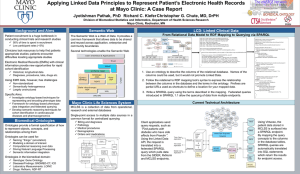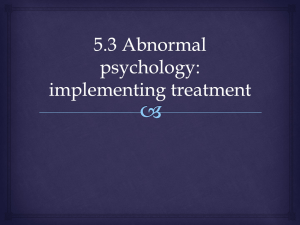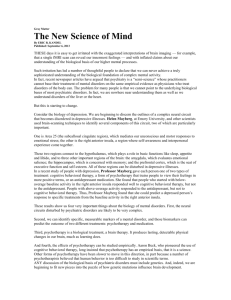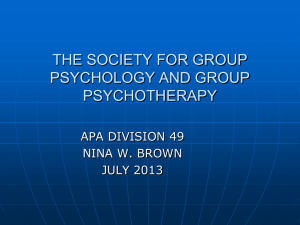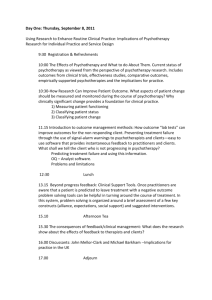Grundfag A: Klinisk psykologi
advertisement
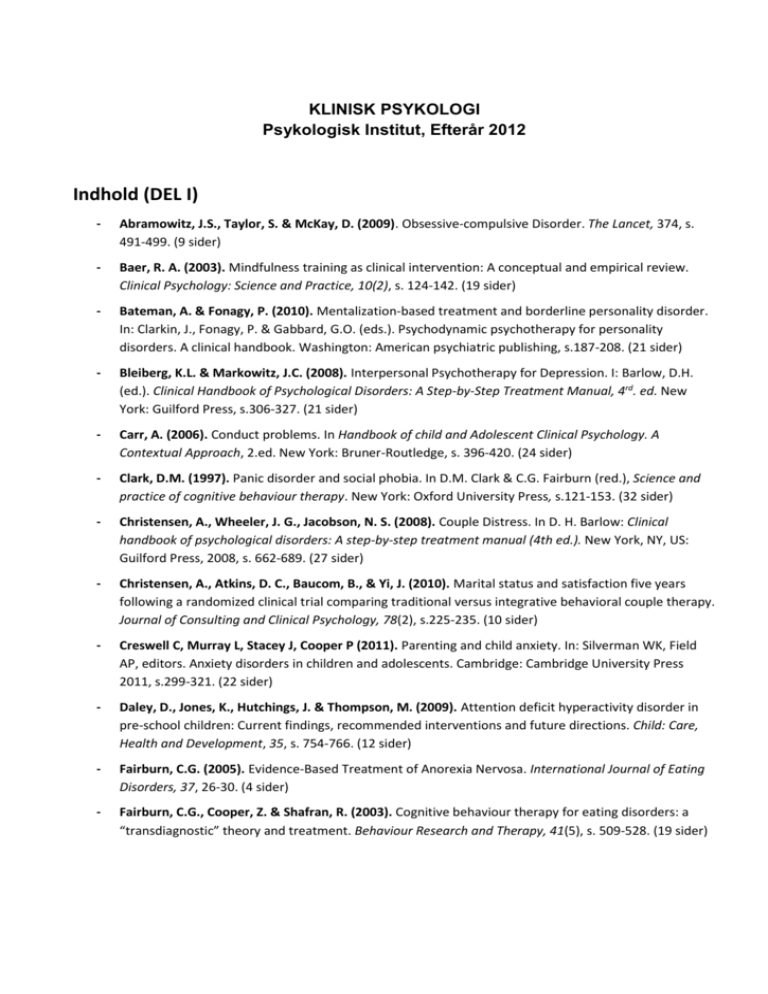
KLINISK PSYKOLOGI Psykologisk Institut, Efterår 2012 Indhold (DEL I) - Abramowitz, J.S., Taylor, S. & McKay, D. (2009). Obsessive-compulsive Disorder. The Lancet, 374, s. 491-499. (9 sider) - Baer, R. A. (2003). Mindfulness training as clinical intervention: A conceptual and empirical review. Clinical Psychology: Science and Practice, 10(2), s. 124-142. (19 sider) - Bateman, A. & Fonagy, P. (2010). Mentalization-based treatment and borderline personality disorder. In: Clarkin, J., Fonagy, P. & Gabbard, G.O. (eds.). Psychodynamic psychotherapy for personality disorders. A clinical handbook. Washington: American psychiatric publishing, s.187-208. (21 sider) - Bleiberg, K.L. & Markowitz, J.C. (2008). Interpersonal Psychotherapy for Depression. I: Barlow, D.H. (ed.). Clinical Handbook of Psychological Disorders: A Step-by-Step Treatment Manual, 4rd. ed. New York: Guilford Press, s.306-327. (21 sider) - Carr, A. (2006). Conduct problems. In Handbook of child and Adolescent Clinical Psychology. A Contextual Approach, 2.ed. New York: Bruner-Routledge, s. 396-420. (24 sider) - Clark, D.M. (1997). Panic disorder and social phobia. In D.M. Clark & C.G. Fairburn (red.), Science and practice of cognitive behaviour therapy. New York: Oxford University Press, s.121-153. (32 sider) - Christensen, A., Wheeler, J. G., Jacobson, N. S. (2008). Couple Distress. In D. H. Barlow: Clinical handbook of psychological disorders: A step-by-step treatment manual (4th ed.). New York, NY, US: Guilford Press, 2008, s. 662-689. (27 sider) - Christensen, A., Atkins, D. C., Baucom, B., & Yi, J. (2010). Marital status and satisfaction five years following a randomized clinical trial comparing traditional versus integrative behavioral couple therapy. Journal of Consulting and Clinical Psychology, 78(2), s.225-235. (10 sider) - Creswell C, Murray L, Stacey J, Cooper P (2011). Parenting and child anxiety. In: Silverman WK, Field AP, editors. Anxiety disorders in children and adolescents. Cambridge: Cambridge University Press 2011, s.299-321. (22 sider) - Daley, D., Jones, K., Hutchings, J. & Thompson, M. (2009). Attention deficit hyperactivity disorder in pre-school children: Current findings, recommended interventions and future directions. Child: Care, Health and Development, 35, s. 754-766. (12 sider) - Fairburn, C.G. (2005). Evidence-Based Treatment of Anorexia Nervosa. International Journal of Eating Disorders, 37, 26-30. (4 sider) - Fairburn, C.G., Cooper, Z. & Shafran, R. (2003). Cognitive behaviour therapy for eating disorders: a “transdiagnostic” theory and treatment. Behaviour Research and Therapy, 41(5), s. 509-528. (19 sider) - Frank, J.D. (1982). Therapeutic components shared by all psychotherapies. I: J.H. Harvey & M.M. Parts (red.), The Master Lecture Series. Vol. 1. Psychotherapy Research and Behavior Change. Washington: Amerian Psychological Association, s. 7-37. (30 sider) - Freud, S. (1914). Erindren, gentagen og gennemarbejden. I: Freud, S. Afhandlinger om behandlingsteknik. København: Hans Reitzels Forlag 1992, s. 153-160. (7 sider) - Garfield, D.A.S. (2009). Psychotic themes in the precipitating event. Unbearable affect: A guide to the psychotherapy of psychosis, (2nd ed., revised). Karnac Books: London, s. 31-44 (13 sider) - Garner, D.M. & Neddleman, L.D. (1997). Sequencing and Integration of Treatments. In D.M. Garner & P.E. Garfinkel (Eds.). Handbook of Treatment for Eating Disorders. 2nd Ed. New York: Guilford Press, s.50-63. (13 sider) - Helt, M., Kelley, E., Kinsbourne, M., Pandey, J., Boorstein, H., Herbert, M. & Fein, D. (2008). Can Chilren With Autism Recover? If So, How? Neuropsychological Review, 18, s.339-366. (27 sider) - Hougaard, E. (2004a). Psykoterapi: Teori og forskning. København: Dansk Psykologisk Forlag, kapitel 4, s.81-119. (38 sider) - Hougaard, E. (2004b). Psykoterapi: Teori og forskning. København: Dansk Psykologisk Forlag, kapitel 7, s.197-226 (29 sider) Indhold (DEL II) - Jørgensen, C.R. (2004). Active Ingredients in Individual Psychotherapy. Searching for the Common Factors. Psychoanalytic Psychology, vol.21, s. 516-40. (24 sider) - Killingmo, B. (1989). Conflict and deficit: Implications for technique. International Journal of Psychoanalysis, 70, 65-79. (14 sider) - Lieberman, A. F. & van Horn, P. (2009). Child-parent psychotherapy: A developmental approach to mental health treatment in infancy and early childhood. I C. H. Zeanah (Ed.), Handbook of Infant Mental Health, 3rd. Ed. New York: Guilford Press, s. 439-449. (10 sider) - Luborsky, L. (1997). The core conflictual relationship theme: A basic case formulation method. I: T.D. Eells (red.), Handbook of psychotherapy case formulation. New York: Guilford, s. 58-83. (25 sider) - Mesibov, S. & Schopler, E. (2004). The TEACCH approach to autism spectrum disorders. Springer Science, New York, s. 33-49. (16 sider) - Muran, J.C. & Safran, J.D. (2002). A Relational Approach to Psychotherapy. I: F.W. Kaslow & J.J. Magnavita (red.), Comprehensive Handbook of Psychotherapy, vol. 1. New York: Wiley & Sons, s. 253281. (28 sider) - Nordahl, T., Sørlie, M., Manger,T. & Tveit, A. (2008). Virksomme modeller for tiltag og indsatser. In Adfærdsproblemer hos børn og unge. Teoretiske og praktiske tilgange, Dansk Psykologisk Forlag Kbh, s. 131-169. (38 sider) - Pelham, W.E. & Walker, K.S. (2005) Attention Deficit Hyperactivity Disorder. In P. Graham (Ed.). Cognitive-Behaviour Therapy for Children and Families. Cambridge University Press, s. 225-243. (18 sider) - Polivy, J. & Federoff, I. (1997). Group Psychotherapy. In D.M. Garner & P.E. Garfinkel (Eds.). Handbook of Treatment for Eating Disorders, 2nd Ed. New York: Guilford Press, s. 462-475. (13 sider) - Rapee, R.M., Schniering, C.A., & Hudson, J.L. (2009). Anxiety Disorders During Childhood and Adolescence: Origins and Treatment. Annu Rev Clin Psychol, 5, 311-341. (30 sider) - Rosenberg, N.K. & Mørch, M.M. (2005). Kognitiv terapi. I: Mørch, M.M. & Rosenberg, N.K. (red.). Kognitiv terapi: Modeller og metoder. København: Hans Reitzels Forlag, s. 17-45. (28 sider) - Salkovskis, P.M. (1999). Understanding and treating obsessive compulsive disorder. Behavior Research and Therapy. Special Issue: Cognitive Behavior Therapy: Evolution and Prospects, 37 (1), s. 29-52. (23 sider) - Segal, Z. V., Teasdale, J. D., & Williams, J. M. G. (2004). Mindfulness-based cognitive therapy: Theoretical rationale and empirical status. I: S. C. Hayes, V. M. Folette & M. M. Linehan (eds.), Mindfulness and Acceptance: Expanding the Cognitive-Behavioral Tradition. New York: Guilford Press, s. 45-65. (20 sider) - Svendsen, B. (2007): Utvikling av allianse i psykoterapi med barn, i Hanne Haavind og Haldor Øvreeide (red): Barn og Unge i psykoterapi. Gyldendal Akademisk. Oslo, s. 69-96. (30 sider) - Young, S. & Amarasinghe, J. M. (2010). Practitioner review: Non-pharmaligical treatments for ADHD: A lifespan approach. The Journal of Child Psychology and Psychiatry, 51, s. 116-133. (17 sider) - Young, J.E. & Beharty, W.T. (1999). Schema focused therapy for personality disorders. I: N. Tarrier, A. Wells & G. Haddock (red.), Treating complex cases: The cognitive behavioural approach. New York: Wiley & Sons, s. 340-368. (28 sider) Ud over disse er følgende tekster på pensum: - Barber, J.(2009). Toward a working through of some core conflicts in psychotherapy research. Psychotherapy Research, vol.19, s.1-12 - Barlow, D.H., Gorman, J.M., Shear, M.K. & Woods, S.W. (2000). Cognitive-Behavioral Therapy, Imipramine, or their Combination for Panic Disorder: A Randomized Trial. Journal of the American Medical Association, vol.283, s.2529-36. - Bateman, A. & Fonagy, P. (1999). Effectiveness of Partial Hospitalization in the Treatment of Borderline Personality Disorder: A Randomized Controlled Trial. American Journal of Psychiatry, vol.156, s.1563-69. - Bateman, A. & Fonagy, P. (2008). 8-Year follow-up of Patients Treated for Borderline Personality Disorder: Mentalization-Based Treatment Versus Treatment as Usual. American Journal of Psychiatry, vol.165, s.631-38. - Bateman, A. & Fonagy, P. (2006). Mentaliseringsbaseret behandling af borderline personlighedsforstyrrelser. København: Akademisk Forlag, s.137-85. - Bateman, A. & Holmes, J. (1995 [1999]). Introduktion til psykoanalyse. Nutidig teori og praksis. København: Hans Reitzels Forlag, s.45-67 + 97-141 + 181-211. - Carr A (2006). Family therapy. Concepts, process and practice. 2 ed. Chichester: John Wiley & Sons; 2006, s.48-75, 90-95, 135-138, 180-183 & 273-316. - Chu, J.A. (2011) The Therapeutic Roller Coaster: Phase-Oriented Treatment for Complex PTSD. In: Chu, J. Rebuilding Shattered Lives, 2nd Ed. Hoboken:John Wiley & Sons, s.75-91 - DeRubeis, R.J,. Hollon, S.D., Shelton, R.C. & Amsterdam, J.D. et al. (2005). Cognitive Therapy vs. Medications in the Treatment of Moderate to Severe Depression. Archives of General Psychiatry, vol.62, s.409-16. - Fog, J. & Hem, L. (2009). Psykoterapi og erkendelse. Personligt anliggende og professionel virksomhed. København: Akademisk Forlag, s.25-36 + s.113-84. - Fonagy, P. & Target, M. (2010) Psychodynamic Treatments . I: Rutter M. et al.: Rutter´s Child and Adolescent Psychiatry. 5th Revised edition. London: Wiley, s. 1079 -1091 - Gumley A.I. (2010) Staying well after psychosis: A Cognitive Interpersonal approach to emotional recovery and relapse prevention. In Hagen R. & Turkington D. CBT for Psychosis: A symptom based approach. London: Routledge. - Hembree, E.A., Foa, E.B. (2010) Cognitive Behavioral Treatments for PTSD. In: Rosen, G.M. & Frueh, B.C. (eds) Clinician's guide to posttraumatic stress disorder. Hoboken, NJ, US:John Wiley & Sons Inc., s.177-203. - Hinshaw, S.P. (2007) Moderators and Mediators of Treatment Outcome for Youth With ADHD: Understanding for Whom and How Interventions Work. Journal of Pediatric Psychology, 32 (6), s.664675. - Hollon, S.D., DeRubeis, R.J., Shelton, Amsterdam, J.D. et al. (2005). Prevention of Relapse Following Cognitive Therapy vs. Medications in Moderate to Severe Depression. Archives of General Psychiatry, vol.62, s.417-22. - Horvath, A.O., Del Re, A.C., Flückiger, C.& Symmonds, D. (2011). Alliance in individual psychotherapy. Psychotherapy, vol. 48, s.9-16. - Jørgensen, C.R. (2009). Personlighedsforstyrrelser. Moderne relationel forståelse og behandling af borderlinelidelse 2.udgaver. København: Hans Reitzels Forlag, kap.5, s.404-77. - Kingdom, D. (1999). Cognitive behavioural therapy of psychosis: Complexities in engagement and therapy. I: N. Tarrier, A. Wells, G. Haddock (red.), Treating complex cases: The cognitive behavioural approach. New York: Wiley & Sons, s.176 – 194. - Linehan, M.M. & Dexter-Mazza, E.T. (2008). Dialectical Behavior Therapy for Borderline Personality Disorder. I: D.H. Barlow (ed.). Clinical handbook of psychological disorders. A Step-by-Step Treatment Manual, 4rd. New York: Guilford, s.365-420. - Midgley, N. (2009): Research in child and adolescent psychotherapy: An overview, In Monica Lanyado and Ann Horne (ed.): The Handbook of Child and Adolescent Psychotherapy. Psychoanalytic Approaches.. Routledge. London and New York. s 73-97. - Morrison, A. P et al. (2004). Cognitive therapy for the prevention of psychosis in people at ultra-high risk: Randomised controlled trial. British Journal of Psychiatry, 185, s.291-297. - Paul, R. (2008). Interventions to improve communication in autism. Child and adolescent psychiatric clinics of North America, 17(4), s.835-856. Sidetal og % sats ok. Tjek licens. - Rosenbaum, B. & Harder, S. (2007). Psychosis and the dynamics of the psychotherapy process. International Review of Psychiatry, 19(1), 13-23. - Silverman, W.K., Pina, A.A., & Viswesvaran, C. (2008). Evidence-based psychosocial treatments for phobic and anxiety disorders in children and adolescents. J Clin Child Adolesc Psychol, 37, 105-30. - Wampold, B.E. (2010). The Research Evidence for Common Factors Models: A Historically Situated Perspective. I: Duncan, B.L., Miller, S.D., Wampold, B.E. & Hubble, M.A. (eds.), The heart and soul of change. Delivering What works in therapy. 2nd.ed. New York: American Psychological Association, s.4973 + reference. - Young, J.E., Rygh, J.L, Weinberger, A. & Beck, A.T. (2008). Cognitive Therapy for Depression. I: Barlow, D.H. (ed.). Clinical Handbook of Psychological Disorders: A Step-by-Step Treatment Manual, 4rd. ed. New York: Guilford Press, s.250-306
